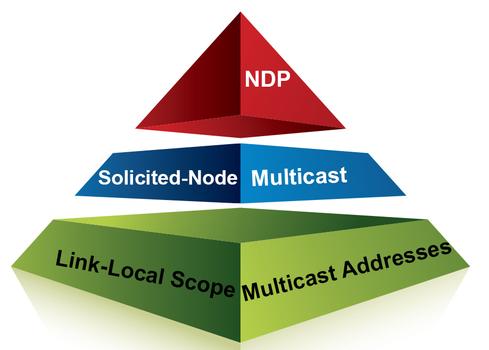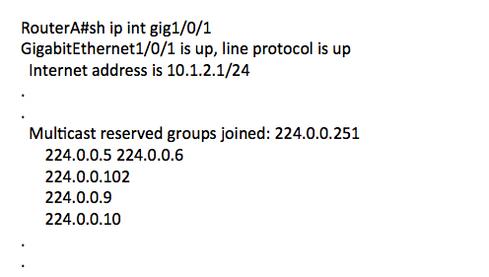Solicited-node multicast: I stumbled over this one in the beginning. Well, that isn’t 100% true. Admittedly, at first, I really just ignored it, which really got in the way of my understanding some of the fundamentals of Neighbor Discovery Protocol (NDP).
But before we jump into solicited-node multicast, let’s review link-local scope multicast addresses.
Multicast is all around you
Multicast is all around your current IPv4 network. You might not think so if you haven’t enabled IP multicast routing and PIM, but it's there. Pretty much everywhere you turn, it's there.
Let’s return to our RouterA/RouterB environment. But let’s have IPv4 only running right now, like probably a lot of your routers in your environment.
Show IP interface
This is often an overlooked command, which is a shame because there is a great deal of very useful information that is given in the output. For now, we're going to focus on the line “multicast reserved groups joined” and ignore all the other lines.
See? Lots and lots of multicast! To be specific, lots of “Local Network Control Block (224.0.0.0 - 224.0.0.255 (224.0.0/24),” according to the Internet Assigned Numbers Authority (IANA).
So what does this mean? This means that according to the show ip int gig1/0/1, that interface has “joined” these groups and is also listening for the packets on the wire with the corresponding MAC address (based on IETF RFC 1112 standard) for those multicast IP addresses. Let’s look at a few of those groups in the table below.
|
Multicast IPv4 Address
|
Ethernet Address
|
Description
|
|
224.0.0.5
|
01:00:5e:00:00:05
|
OSPFIGP All Routers
|
|
224.0.0.6
|
01:00:5e:00:00:06
|
OSPFIGP Designated Routers
|
|
224.0.0.9
|
01:00:5e:00:00:09
|
RIP2 Routers
|
|
224.0.0.10
|
01:00:5e:00:00:0a
|
IGRP Routers
|
|
224.0.0.102
|
01:00:5e:00:00:66
|
HSRP
|
These look familiar don’t they? So, see? As I said, you are running lots and lots of multicast in your IPv4 network right this very second.
You probably don’t even really think about this as “real multicast” because this range, 224.0.0.0 to 224.0.0.255, stays on the local wire or link. But it is.
As we saw in my earlier post, IPv6 also has a “link-local scope multicast address range.” For example, looking at just OSPF, RIPv2, and EIGRP, their IPv6 equivalents are as follows:
|
Multicast IPv6 Address
|
Ethernet Address
|
Description
|
|
FF02:0:0:0:0:0:0:5
|
33:33:00:00:00:05
|
OSPFIGP All Routers
|
|
FF02:0:0:0:0:0:0:6
|
33:33:00:00:00:06
|
OSPFIGP Designated Routers
|
|
FF02:0:0:0:0:0:0:9
|
33:33:00:00:00:09
|
RIP2 Routers
|
|
FF02:0:0:0:0:0:0:A
|
33:33:00:00:00:0A
|
EIGRP Routers
|
What do these multicast groups have in common?
- Local: They are local to the wire they are on and don’t go off that wire
- Join: These joined groups are not joined via IGMP. Each device simply “joins” by just deciding to listen to an IPv4 or IPv6 local multicast address and then, by extension, to the corresponding MAC address for that multicast IP address.
- Common interest: As we can see, all of these varying groups share something in common. For example, 224.0.0.10 is for all IPv4 devices that have a common interest: EIGRP in IPv4. It's just that simple: If a router wants to participate in EIGRP, it already knows the local multicast address (IPv4/IPv6) to start to listen to and the corresponding MAC address. They have something “in common” that they would all like to hear about.
You will see in this post that these three bullets (local, join, and common interest) will be seen again, but with slightly different text.











